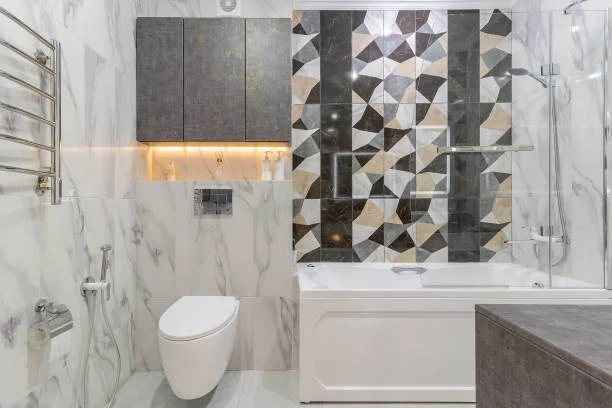Small bathrooms present this weird challenge where every design choice either makes the space feel bigger or turns it into a cramped box. Bathroom tiles play a massive role in this perception game because they cover so much surface area—typically 60-80% of visible space when you factor in floors and walls. Interior designers have studied how tile choices affect spatial perception, finding that certain patterns can make a 5×7 foot bathroom feel nearly 20% larger visually. The tile industry has responded with smaller format tiles, larger slabs, and everything in between, giving you way more options than the standard white subway tile that dominated bathrooms for decades.
Size Matters But Not How You’d Expect
There’s this old rule saying small spaces need small tiles, but that’s actually backwards in most cases. Large format bathroom tiles—anything 12×24 inches or bigger—create fewer grout lines, which means fewer visual interruptions. Your eye travels across the surface more smoothly, making the space feel more expansive. A small bathroom with 24×48 inch tiles might only have 15-20 grout lines total, compared to 200+ lines if you used 3×6 inch subway tiles.
But here’s where it gets interesting. Mosaic tiles under 2 inches can also work really well in small bathrooms when used strategically. A mosaic accent wall or shower niche creates a focal point that draws attention and adds depth. The key is not covering every surface in tiny tiles, which creates visual chaos, notes Atara Property Management solutions.
More thought-provoking reads await you in our related content section.
Color Psychology for Tight Spaces
Light colors reflect more light, which is why white and pale gray dominate small bathroom designs. But the science behind it is cooler than you’d think. White tiles reflect about 75-85% of light that hits them, while dark colors absorb 85-90%. In a windowless 40-square-foot bathroom, this difference can mean needing two fewer light fixtures to achieve the same brightness level.
That said, going all-white can feel sterile and boring. Two-tone schemes work better—light walls with a darker floor create grounding without shrinking the space. Navy, charcoal, or even black floor tiles hide water spots and wear better in high-traffic areas. Studies on color perception show that darker floors with lighter walls create an expansive feeling because they mimic natural outdoor environments where ground is dark and sky is light.
Pattern Tricks That Actually Work
Diagonal tile layouts make rooms feel wider because they force your eye to follow the longest possible line across the space. A 6×8 foot bathroom with tiles laid diagonally suddenly has 10-foot sight lines instead of 6 and 8-foot lines. This trick works with any tile size.
Vertical patterns pull the eye upward, making ceilings feel higher. Running wall tiles vertically instead of horizontally in a standard 8-foot bathroom can create the illusion of 9-foot ceilings. Stacking tiles without offset (called a grid or stack bond pattern) emphasizes this vertical movement even more.
Herringbone and chevron patterns add visual interest without overwhelming small spaces, but they need to be scaled appropriately. A tight herringbone using 3×12 inch tiles looks sophisticated. Using 6×24 inch tiles in the same pattern just looks off because the angles become too dramatic.
Grout Color Is More Important Than People Think
Grout color changes everything. Matching your grout to your tile color creates a seamless look that makes surfaces appear larger and more continuous. Contrasting grout—like dark grout with white tiles—creates a grid effect that can look stunning but definitely makes the space feel busier.
Grout joints themselves matter too. Unsanded grout works for joints under 1/8 inch and creates a smoother finish. Sanded grout for wider joints is more durable but has a coarser texture. In small bathrooms where you’re close to every surface, these textural details become noticeable.
Reflective Surfaces Multiply Light
Glossy tiles reflect light and create depth by showing subtle reflections of the room. A glossy white subway tile reflects about 40% more light than a matte version of the same tile. This matters in bathrooms with limited natural light.
Glass tiles take this concept further. They’re translucent, so light doesn’t just reflect off the surface—it passes through the tile body and bounces off the adhesive and wall behind it. This creates a glowing effect that’s especially nice in shower areas. Glass tiles run about $25-45 per square foot compared to $8-15 for ceramic, but the visual impact in small spaces might be worth it.
Don’t hold back — explore more reads on Management Works Media that keep the spark alive.






